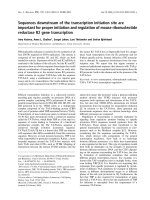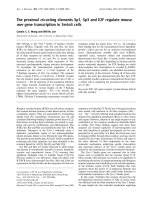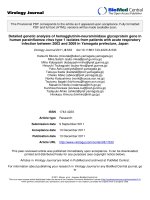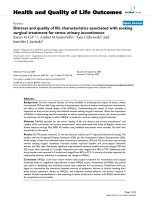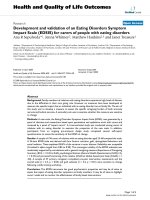Transplantation and improvement of mouse embryo progenitor derived insulin producing cells for type 1 diabetes therapy
Bạn đang xem bản rút gọn của tài liệu. Xem và tải ngay bản đầy đủ của tài liệu tại đây (2.98 MB, 159 trang )
TRANSPLANTATION AND IMPROVEMENT OF MOUSE EMBRYO
PROGENITOR-DERIVED INSULIN-PRODUCING CELLS FOR TYPE 1
DIABETES THERAPY
SHAO SHIYING
NATIONAL UNIVERSITY OF SINGAPORE
2010
TRANSPLANTATION AND IMPROVEMENT OF MOUSE
EMBRYO PROGENITOR-DERIVED INSULIN-PRODUCING
CELLS FOR TYPE 1 DIABETES THERAPY
SHAO SHIYING
(M.Sc., TONGJI University)
A THESIS SUBMITTED
FOR THE DEGREE OF PHILOSOPHY OF DOCTORATE
NATIONAL UNIVERISTY OF MEDICAL INSTITUTES
DEPARTMENT OF BIOCHEMISTRY
NATIONAL UNIVERSITY OF SINGAPORE
2010
i
ACKNOWLEDGEMENTS
First of all, I would like to express my sincere appreciation and thanks to my
supervisor A/P Li Guodong for his invaluable guidance, support and encouragement
during the course of this research. This research would not have been possible
without his insightful ideas.
Many thanks to all my fellow lab-mates, Ruihua, Jiping, Xiefei, Heqing, Michelle,
Gao Yun and Xie Bing in NUMI for the useful discussion sessions that helped me
throughout the research. My appreciation also goes out to my friends, Bai Jie, Zhu
Yi, Hanfeng, Tiannan, Shugui, Niandan, Tangmei and Li Xi who helped me
tremendously all along and provided me with many useful inspirations.
Special thanks to my devoted parents and sister Qin, who offered me with never
ending supports, encouragements and the very academic foundations that make
everything possible.
Finally, I would like to thank the National University of Singapore for facilities and
generous financial support that makes this research project a success.
ii
PUBLICATION LIST
Full papers:
Shiying Shao, Yun Gao, Bing Xie, Fei Xie, Sai Kiang Lim, GuoDong Li. (2011)
.
Correction of hyperglycemia in type 1 diabetic models by transplantation of
encapsulated insulin-producing cells derived from mouse embryo progenitor. J
Endocrinol. 208:245-255, e-pub
Shiying Shao, Yun Gao, Ruihua Luo, Wataru Nishimura, Arun Sharma, GuoDong Li.
Improvement of insulin-producing cells derived from mouse embryo progenitor by
enhancement of MafA expression. Manuscript to be submitted
Conference papers:
Shao S, Gao Y, Xie B, Lim SK, Li GD (2010) Optimization of mouse embryo
progenitor-derived insulin-producing cells for diabetes treatment. Poster presentation
at the 8th ISSCR Annual Meeting, 16-19 June, 2010, San Francisco, USA
Shao S, Li GD. (2009) Improvement of mouse embryo progenitor-derived
insulin-producing cells for type 1 diabetes therapy. Poster presentation at 49th
Annual Meeting of American Society for Cell Biology, 5-9 December 2009, San
Diego, USA. Mol Biol Cell 20(suppl.):#116/B63 (online)
Shao S, Wu H, Lim SK, Li GD. (2009) Fate of encapsulated insulin-producing cells
derived from mouse embryonic progenitor cells following transplantation in immune
competent diabetic mice. In: Friday Poster Session Abstracts Book, p.21. Presented at
the 7th ISSCR Annual Meeting, 8-11 July, 2009, Barcelona, Spain
Shao S, Xie F, Li GD. (2008) Functional characterization in vivo and in vitro of
encapsulated insulin-producing cells derived from mouse embryo progenitor.
Diabetologia 51 (suppl. 1):S182. Poster at 44th Annual Meeting of the European
Association for the Study of Diabetes (EASD), 7-11 Sep 2008, Rome, Italy
Li GD, Shao S, Xie F, Luo R, Wu H. (2008) Functional assessment of mouse ESC-
and progenitor-derived insulin-producing cells following encapsulation and
transplantation in type 1 diabetic animals. In: Poster Session Abstracts book, p.151.
Presented at the 6th ISSCR Annual Meeting, 11-14 June, 2008, Philadelphia, PA,
USA
Shao S, Xie F, Luo R, Salto-Tellez M, Lim SK, Li GD. (2007) Transplantation of
encapsulated embryonic progenitor-derived insulin-producing cells reverses
hyperglycemia in immune-competent diabetic animals. Presented at 67th ADA
Annual Scientific Sessions, 21-26 June, 2007, Chicago, IL, USA. Diabetes 56(suppl.
1): A520
iii
TABLE OF CONTENTS
ACKNOWLEDGEMENTS i
PUBLICATIONS ii
TABLE OF CONTENTS iii
SUMMARY vii
TABLES AND FIGURES viii
ABBREVIATIONS x
CHAPTER 1 INTRODUCTION
1.1 General background 2
1.1.1 Diabetes mellitus and traditional therapy…………………………… …2
1.1.2 Islets of Langerhans and -cell function………… …………………….3
1.1.3 Glucose-stimulated insulin secretion ……………………………….… 6
1.1.4 Insulin secretion regulation…………………………….……………… 7
1.2 Transplantation therapy for type 1 diabetes…………………….……………9
1.2.1 Human islet transplantation for type 1 diabetes mellitus…………… …9
1.2.2 Substitute -cell therapy for type 1 diabetes mellitus………………….11
1.2.3 Characteristics of mouse embryo progenitor derived insulin-producing
cells………………………………………………………… ………………13
1.2.4 Transplantation of MPEI-1 cells in immune-deficient mice………… 14
1.2.5 Microencapsulation techniques……………………………………… 15
1.2.5.1 Ratinale of encapsulation of cells……………………………… 15
1.2.5.2 Principle and application of encapsulation……………………… 16
1.3 Roles of Maf A in-cell development and function.…………………… 19
1.3.1 GSIS-related genes in -cells………………………………………… 19
1.3.2 Transcription factors regulating GSIS-related genes ……… 20
1.3.3 Subtypes of Maf family………………………… ……………………21
1.3.4 Regulatory elements controlling insulin gene transcription …………22
1.3.5 Characters and role of MafA…………………………… ………… 23
1.3.6 Regulation of MafA…………………… …………………………… 25
1.4 Aim and significance of the study……… ……………………………… 25
CHAPTER 2 MATERIALS AND METHODS
2.1 Materials……………………………………………… ………………….30
2.2 Methods for microencapsulation and transplantation…………… …… 33
2.2.1 MEPI-1cell culture and storage……………………………… ………33
2.2.2 Microencapsulation………………………………… ……………… 34
2.2.3 Transplantation and washing-out of capsules………………… …… 35
2.2.4 Measurement of insulin secretion of microcapsules ………… …… 36
2.2.5 Measurement of cell number in microcapsule………………… …… 37
2.2.5.1 DNA content detection 37
iv
2.2.5.2 Insulin content determination 37
2.2.6 Immunohistochemistry……………………… ……………………….37
2.2.6.1 Brdu staining……………………… …………………………… 37
2.2.6.2 Insulin staining……………………………………… ……………38
2.2.6.3 H&E staining……………………………………… …………… 38
2.2.7 Permeability detection of microcapsules………………………… … 39
2.2.8 Determination of plasma insulin……………….………………… ….39
2.2.9 Oral glucose tolerance Test (OGTT)…………………….………… …39
2.2.10 Cytokine measurement…………………………………………… …39
2.3 Methods for experiments on MafA ……………………… …………… 40
2.3.1 Molecular biology……………………… …………………………….40
2.3.1.1 E.Coli transformaotion………………………………… …………40
2.3.1.2 Plasmid DNA preparation……………………………… ……… 40
2.3.1.3 Construction of recombinant lentiviral vectors containing mouse
MafA cDNA……………………………………………………… 41
2.3.1.3.1 Hotstar hifidelity PCR…………………………………….……41
2.3.1.3.2 Restriction enzyme digestion…………………………… ……42
2.3.1.3.3 Construction of entry clone PENTR3C-MafA…………………42
2.3.1.3.4 LR recombination………………………………………………43
2.3.1.3.5 pLenti-MafA virus collection and storage……………… ……43
2.3.1.4 Up-regulation of MafA in MEPI-1 cells……… …………… … 44
2.3.1.4.1 Transient up-regulation of MafA in MEPI-1 cells… …… ….44
2.3.1.4.2 Stable up-regulation of MafA in MEPI-1 cells……… ……….44
2.3.2 mRNA assay………………………………………………… ……….45
2.3.2.1 RNA purification……………………………………… …………45
2.3.2.2 Reverse transcription……………………………………… …… 45
2.3.2.3 Polymerase chains reaction…………………………………… ….46
2.3.2.4 Real-time RT-PCR………………………… ………………….…47
2.3.3 Protein assay………………………………… ……………………….47
2.3.3.1 Protein extraction…………………………………… ……………47
2.3.3.2 Measurement of protein concentrations…………………… …… 48
2.3.3.3 Western blotting………………………………………… ……… 48
2.3.4 Measurement of insulin secretion and content in cell monolayer.…… 50
2.3.5 Measurement of membrane potential………………… ………………51
2.3.6 Measurement of intracellular Ca
2+
concentration……………… …….52
2.3.7 Glucose metabolism…………………………………………… …… 52
2.3.7.1 Assessment of glucose metabolism by MTS assay…………… ….52
2.3.7.2 Assessment of glucose metabolism by ATP detection……… … 53
2.3.8 Examination of cell growth and death…………………………… … 53
2.3.9 RT
2
profiler PCR array…………………………………… ………….55
2.4 Statistical analysis…………………………………… ………………… 56
CHAPTER 3 RESULTS
3.1 Transplantation of microencapsulated MEPI-1 cells in diabetic mice…… 58
3.1.1 Morphology of microcapsules in vitro and in vivo…………………….58
3.1.2 Glucose-stimulated insulin secretion in encapsulated cells.… ………59
3.1.3 Reversing hyperglycemia in diabetic mice by transplantation of
encapsulated MEPI-1 cells…………… ………………………… …….… 61
3.1.3.1 Glucose levels after transplantation of MEPI-1 cells without
encapsulation………… …………………………………….…………….61
v
3.1.3.2 Glycemic changes after transplantation of encapsulated MEPI-1
cells……………………………………………………………………… 62
3.1.3.3 Effects of repeated transplantation of encapsulated MEPI-1 cells 65
3.1.3.4 Glycemic changes after washing out of transplanted
microcapsules …………………………………………………………… 66
3.1.4 Properties of MEPI-1 cells in microcapsules…………………….…….67
3.1.4.1 Cell growth rate in vivo…………………………… … ……… 67
3.1.4.2 Cell growth rate in vitro……………… ……………… …………68
3.1.4.3 Correlation of cell growth and glycemic level… ……… …….…69
3.1.4.4 Cell population doubling time…………………… ………………72
3.1.5 Plasma insulin level in capsule-transplanted diabetic mice……… ….74
3.1.6 Oral glucose tolerance test in capsule-transplanted diabetic mice… …75
3.1.7 Histology of microcapsules in vivo and in vitro……………… …… 77
3.1.8 Permeability of microcapsules after transplantation in mice………… 79
3.1.9 Cytokine production in mice implanted with encapsulated MEPI-1
cells………………………………………………………………………… 80
3.2 The roles of MafA in MEPI-1 cells………………… …………………….82
3.2.1 Lower expression level of MafA in MEPI-1 cells………………… …82
3.2.1.1 MafA expression in MEPI-1 cells at mRNA and protein level……82
3.2.1.2 MafA expression in MEPI-1 cells by immunofluorescence
staining………………………………………………………………… 85
3.2.2 MafA restoration improves MEPI-1 cell functions……………… … 86
3.2.2.1 MafA restoration increases glucose metabolism……………… ….86
3.2.2.2 MafA restoration enhances the depolarization of membrane potential
upon glucose stimulation…… ………………………………………… 87
3.2.2.3 MafA restoration augments [Ca
2+
]
i
response…… … 89
3.2.2.4 MafA restoration increases insulin content …90
3.2.2.5 MafA restoration improves glucose-stimulated insulin secretion ….91
3.2.2.6 Effects of MafA restoration on ion fluxes and insulin secretion
stimulated by non-nutrient secretagogues……………………….…….……92
3.2.4 MafA restoration enhances the expression profile of -cell specific
genes…………………………………………………………………….… 95
3.2.5 MafA restoration reduces cell growth rate…………………………… 98
CHAPTER 4 DISCUSSION
4.1 Transplantation of microencapsulated MEPI-1 cells corrects hyperglycemia
in diabetic mice……………………………………………………………….101
4.1.1 Characteristics of alginate microcapsules……….……………….….103
4.1.2 Correction of hyperglycemia by repeated the transplantations for 3
months…………… ……….………………….…………………… 105
4.1.3 Scenarios for hyperglycemia relapse after transplantation……………108
4.1.3.1 The optimal site for transplantation……… ……………… ……109
4.1.3.2 The permeability of transplanted microcapsule……………… 110
4.1.3.3 The immune reaction after microcapsule transplantation ………111
4.1.3.4 Behaviors of microencapsulated MEPI-1 cells.…………….……112
4.1.4 Immaturity of encapsulated MEPI-1 cells…….……………………113
4.1.5 Summary of transplantation of microencapsulated MEPI-1 cells…….116
4.2 Restoration of MafA in MEPI-1 cells………………….……….……… 116
4.2.1 Less-physical characteristics of MEPI-1 cells…………….…………117
4.2.2 MafA up-regulation improves GSIS and related signaling events in
vi
MEPI-1 cells…………………………………….…………………….….…118
4.2.3 The role of MafA in cAMP-involved pathway in MEPI-1 cells…… 123
4.2.4 MafA restoration reduces proliferation of MEPI-1cells………… … 123
4.2.5 MafA up-regulation promotes gene expression profile in MEPI-1
cells…………………………………………………………………….……124
4.2.6 Summary of studies of MafA in MEPI-1 cells…….……………….…128
4.3 Conclusions……………………………………………………………….129
4.4 Future work…………………………………………………… …… …130
REFERENCE LIST……………………………… …………… …… …132
vii
SUMMARY
The application of islet transplantation to cure type 1 diabetics is impeded by
shortage of cadaveric pancreata and requirement of life-long immunosuppression. In
this thesis study, expandable insulin-producing MEPI-1 cells derived from mouse
embryonic progenitor were immuno-isolated by microencapsulation. After
peritoneal transplantation of encapsulated MEPI-1 cells in streptozotocin-induced
diabetic mice, normoglycemia or moderate hypoglycemia was achieved for 2.5
months before a relapse of hyperglycemia. Importantly, a second transplantation in
relapsed mice was as effective in correcting hyperglycemia as in the first one. The
relapse could be due to necrosis resulting from a slow increase of cell mass by
proliferation. To improve MEPI-1 cell maturation toward mature primary -cells,
the level of MafA, a key transcription factor for promoting -cell maturation but expressed
low in MEPI-1 cells, was restored by infection of lentivirus expressing MafA. MafA-restored
MEPI-1 cells up-regulated expression of genes for many molecules important for -cell
function, slowed cell proliferation, enhanced insulin content, lowered basal insulin release
but markedly improved glucose-induced insulin secretion. These data demonstrated a
promising way for the treatment of type 1 diabetics using embryonic stem cells as the
-cell source while preventing immunosuppression via immune-isolation of cells.
viii
TABLES AND FIGURES
Fig. I. Schematic diagram of insulin synthesis and release in -cells………… …5
Fig. II. Scheme of glucose-stimulated insulin release from -cells……………….…7
Fig. III. Key transcription factors involved in insulin gene transcription………… 24
Fig. IV. Genes regulated by MafA…………………………………………………24
Fig. V. Procedure and setup for microencapsulation of cells……………………….35
Fig. VI. The main implantation sites employed in cell encapsulation technology.110
Table 1. Materials and sources 30
Table 2. Program of Hotstar Hifidelity PCR………………………………………42
Table 3. Programs of RT-PCR and real-time PCR…………………………………46
Table 4. Primers used for SYBR Green based real-time PCR…………………… 46
Table 5. Gel compositions for SDS-PAGE……………………………… ……….50
Table 6. Conditions of critical factors in Western blotting …………………………50
Table 7. Program of RT2 reaction………………………………………………….56
Table 8. Cytokines in peritoneal fluid after transplantation of encapsulated MEPI-1
cells…………………………………………………………………………………81
Fig. 1. Barium alginate-made capsules both in vitro and in vivo.…………… 59
Fig. 2. Insulin secretion from encapsulated MEPI-1 cells………………………….60
Fig. 3. Reversing hyperglycemia in STZ-induced immune-competent diabetic mice
by transplantation (Tx) of MEPI-1 cells without encapsulation…………………. 62
Fig. 4. Reversing hyperglycemia in STZ-induced immune-competent diabetic mice
by transplantation (Tx) of encapsulated MEPI-1 cells…………………………… 64
Fig. 5. Reversing hyperglycemia in STZ-induced immune-competent diabetic mice
by repeated transplantations of encapsulated MEPI-1 cells……………………… 65
Fig. 6. Transplantation and wash-out of encapsulated MEPI-1 cells in STZ-induced
immune-competent diabetic mice… ………………………………66
Fig. 7. Growth of encapsulated MEPI-1 cells after transplantation in STZ-treated
diabetic mice……………………………………… ………………………………68
Fig. 8. Growth of encapsulated MEPI-1 cells after culture in vitro …………… 69
Fig. 9. The relationship of growth of encapsulated MEPI-1 cells and glycemic levels
after transplantation in STZ-treated mice…… ……………………………71
Fig. 10. Cell population doubling time in capsules………………… ……………73
Fig. 11. Plasma insulin in mice at different intervals after transplantation of
encapsulated MEPI-1 cells…………………………………………………………74
Fig. 12. OGTT in mice at different intervals after transplantation of encapsulated
MEPI-1 cells……………………………………………………………………… 76
Fig. 13. Histology of encapsulated MEPI-1 cells in vivo and in vitro… …………78
Fig. 14. DAPI staining and permeability of washed-out capsules…………………79
Fig. 15. MafA expression in MEPI-1 cells at mRNA and protein levels……… 84
Fig. 16. Assessment of MafA expression level by immunofluorescence staining 85
Fig. 17. Glucose metabolism in MafA-upregulated MEPI-1 cells…………………87
Fig. 18. Membrane potential in pLenti-DEST and pLenti-MafA MEPI-1 cells… 88
Fig. 19. Responses of [Ca
2+
]
i
in pLenti-DEST and pLenti-MafA MEPI-1 cells… 89
Fig. 20. Insulin content in pLenti-MafA and pLenti-MafA-m1 MEPI-1 cells…… 90
Fig. 21. Glucose-stimulated insulin secretion in MafA-upregulated MEPI-1 cells.92
Fig. 22. Membrane potential, [Ca
2+
]
i
and insulin secretion in MafA-restored MEPI-1
cells……………………………………………………………………… 94
ix
Fig. 23. Gene expression in pLenti-DEST, pLenti-MafA and untreated MEPI-1
cells…………………………………………………………………………………97
Fig. 24. Cell cycle and doubling time in pLenti-DEST-m1 and pLenti-MafA-m1
cells…………………………………………………………………………………99
x
ABBREVIATIONS
All abbreviations are defined where they first appear in the text and some of the
frequently used abbreviations are listed below.
Ac-CoA acetyl-coenzyme A
K
ATP
ATP-sensitive K
+
channel
PLL alginate-polyelectrolyte
ADF actin depolymerizing factor
AFC 7-amino-4-trifluoromethyl coumarin
AGEs advanced glycation end products
AID autoinhibitory domain
AMP Adenosine 3’-monophosphate
ATP adenosine 5’-triphosphate
BSA bovine serum albumin
[Ca
2+
]
i
cytoplasmic free Ca
2+
concentration
cAMP Adenosine 3’,5’-cyclic monophosphate, cyclic AMP
CEBP - CCAAT/enhancer binding protein
Cbl Casitas b-lineage lymphoma
CHAPS 3-[(3-cholamidopropyl)dimethylammonio]-1-propanesulfonic acid
CNC cap’n’collar
DCF 2',7'-dichlorofluorescein
DEPC diethyl pyrocarbonate
DEVD-CHO N-acetyl-Asp-Glu-Val-Asp-aldehyde
DFDA dihydrofluorescein diacetate
DMSO dimethyl sulphoxide
xi
DPBS Dulbecco’s phosphate-buffered saline
DNA deoxyribonucleotide acid
DTT Dithiothreitol
EDTA ethylenediaminetetraacetic acid
EGTA
ethylene glycol-bis(
-Aminoethyl ether)-N,N,N’,N’- tetraacetic
acid
ESC embryonic stem cell
ERKs extracellular signal-regulated kinases
FACS fluorescence-activated cell sorting
FBS fetal bovine serum
FITC fluorescein-5-isothiocyanate
Fos FBJ osteosarcoma oncogene
FoxO Forkhead box-containing protein O
Frap1 FK506 binding protein 12-rapamycin associated protein 1
GCK glucose metabolism enzyme glucokinase
GIP gastric insulinotropic polypeptide
GLP glucagon-like peptide
GLP-1R glucagon-like peptide-1 receptor
Glut2 glucose transporter-2
GSIS glucose-stimulated insulin secretion
HEPES N-[2-hydroxyethyl] piperazine-N’-[2-ethanesulfonic acid]
bHLH basic helix-loop-helix
HNF hepatocyte nuclear factor
HRP horseradish peroxidase
IAPP islet amyloid polypeptide
xii
IGF-1 insulin like growth factor-1
IPF insulin promoter factor
IRS-2 insulin receptor substrate -2
Klf Kruppel-like factor
kDa kilo-Dalton
MafA V-maf musculoaponeurotic fibrosarcoma oncogene homolog A
MAREs Maf recognition elements
MEPI Mouse Embryo Progenitor derived Insulin producing
MEKK MAP kinase kinase kinase
MTS 3-(4,5-dimethylthiazol-2-yl)-5-(3-carboxymethoxyphenyl)-
2-(4-sulfophenyl)-2H-tetrazolium
MWCO molecule weight cut-off
NBCS new born calf serum
NeuroD neurogenic differentiation factor
Nkx6.1
NK6 transcription factor-related, locus 1
PACAP pituitary adenylate cyclase activating protein
PAGE polyacrylamide gel electrophoresis
PBS phosphate-buffered saline
PC prohormone convertase
PCSK1 proprotein convertase subtilisin/kexin type 1
Pdx-1 pancreatic and duodenal homeobox (Pdx)-1
PEG polyethylene glycol
PI phosphatidylinositol
PKA cAMP-dependent protein kinase A
PKC protein kinase C
xiii
PMS phenazine methosulfate
PMSF phenylmethylsulfonyl fluoride
PVDF polyvinylidene difluoride
RER rough endoplasmic reticulum
RNA ribonucleotide acid
SDS sodium dodecyl sulphate
STZ streptozotocin
TBS Tris-buffered saline
TBS-T TBS with 0.5% Tween-20
T1DM Type 1 diabetes mellitus
T2DM Type 2 diabetes mellitus
TEMED N,N,N’,N’-tetra methylthylene diamine
mTOR mammalian target of rapamycin
TRITC tetramethyl rhodamine isothiocyanate
Chapter 1. Introduction
1
CHAPTER 1
INTRODUCTION
Chapter 1. Introduction
2
1. Introduction
Type1 diabetes is an autoimmune disease and treated traditionally by insulin injection
which is unable to completely cure the disease. Therefore, alternative approaches are
being explored for developing better therapy and islet transplantation is one of the most
promising approaches. However, the cadaveric pancreata cannot satisfy the increasing
demands, in addition to the life-long immunosuppression. These are the 2 major
obstacles for the transplantation therapy of diabetes. Therefore, it is significant to
generate insulin-producing cells which can function as surrogate native -cells. It has
been reported that such cells could be induced not only from adult stem cells but also
from embryonic stem (ES) cells. However, these reported substitute cells are generally
heterogeneous, poorly characterized, producing very low insulin and function less
physiologically compared to the normal -cells. In addition, they could also stimulate
the host immune rejection after transplantation. Consequently, with the purpose of
developing a useful replacement therapy for type 1 diabetes, it is vital to study the way
to avoid immune rejection after transplantation and to generate novel substitute cells
which could function more physiologically as the native -cell does.
The following sections will describe the background of diabetes treatment, the detailed
mechanism and application of microencapsulation technique into transplantation, and
the biological function and role of possible effectors which could act on the function of
insulin-producing cells.
1.1 General background
1.1.1 Diabetes mellitus and traditional therapy
Diabetes is the most common endocrine disease with severe secondary complications
driven by poor glycemic control (1). To date, diabetes in all its forms afflicts at least
Chapter 1. Introduction
3
200 million people in the world and this number is expected to double by the year 2025
(1,2).
Diabetes involves a deficiency of insulin secretion from -cells and/or insulin
resistance, the relative contributions of which vary between different types of diabetes.
Generally, there are two major types of diabetes, i.e., type 1 and type 2.
Type 2 diabetes (T2DM) is caused by the combination of insulin resistance and
impaired -cell function (3-6). Insulin is still produced but the response to
hyperglycemia is blunted. Likewise, the responsiveness of target tissues to insulin is
impaired. It is treated initially by oral hypoglycaemic agents typically. As the disease
progresses, the supplementation of insulin therapy is necessary in the later stages. Type
1 diabetes (T1DM) is caused by autoimmunity against -cells mediated by cytotoxic
T-lymphocytes (7). Pancreatic -cells are destroyed thereby resulting in the absolute
insulin deficiency. It is thought that this process may be triggered by a viral infection
or some other environmental insults. It is traditionally treated with insulin replacement
therapy by insulin injection or insulin pump.
However, the treatment for these two types of diabetes involves complicated
administration and fails to completely cure the disease. In addition, patients with
T1DM are absolutely dependent on insulin infusion which would bring various side
effects among which, hypoglycemia can be fatal. Consequently, it is necessary to
develop alternative approaches to treat the diseases.
1.1.2 Islets of Langerhans and -cell function
The insulin-secreting -cells make up 65-80% of the islets of Langerhans (discovered
by Paul Langerhans in 1869) which are irregularly shaped clusters of endocrine cells
scattered throughout pancreas. There are approximately one million islets in a healthy
Chapter 1. Introduction
4
adult human constituting around 1-2% of the mass of the pancreas. Besides -cells,
the islet of Langerhans is composed of a small quantity (20-40%) of other endocrine
cells (i.e. -, -, PP- and ghrelin-cells) (8,9). -Cells are responsible for synthesizing
the hormone glucagon, which elevates glucose level by stimulating the release of
glucose from liver and other cells. Additionally, -cells could induce the release of
fatty acids from adipose tissue. -Cells produce somatostatin, which could inhibit the
action of somatotropin (a major pituitary hormone), insulin and glucagon. PP-cells
secretes pancreatic polypeptide, which slows down nutrient absorption from the gut.
They are very few in number and are polygonal in shape (8,9).
The essential function of -cells is to biosynthesize and release insulin, a hormone that
controls the blood glucose level (Fig. I). The inactive form of insulin, known as
preproinsulin, is a single chain precursor. It is cleaved by a signal peptidase located at
RER membrane to generate proinsulin which is constituted by a C-peptide (35 amino
acids) at the centre region together with A-chain (21 amino acids) and B-chain (30
amino acids) at the two ends separately (10,11). After being transported to the Golgi
apparatus, proinsulin is packaged into secretory granules. Within such immature
granules, proinsulin undergoes a series of maturation steps. First, the C-peptide is
clipped off from proinsulin by the action of pro-hormone convertases (PC1/3 and
PC2). Thereafter, an equal molar amount of C-peptide and mature insulin consisting of
A-chain and B chain connected by 2 disulfide bonds are formed. They are stored in
matured secretory granules and secreted together upon stimulation (10).
C-peptide, as a by-product of insulin production, has biological role in preventing the
development of neuropathy and other vascular related diabetic symptoms (11,12).
Moreover, the circulatory levels of C-peptide may indicate the viable -cell mass when
patients are receiving insulin treatment (11).
Chapter 1. Introduction
5
Fig. I. Schematic diagram of insulin synthesis and release in -cells
The preproinsulin is cleaved at rough endoplasmic reticulum (RER) membrane to
generate proinsulin which is constituted by a C-peptide together with A-chain and
B-chain at the two ends separately. Proinsulin is packed into secretory granules after
transported to the Golgi apparatus. Within such immature granules, the C-peptide is
clipped off by PC1/3 and PC2 from proinsulin to form mature insulin which is stored in
matured secretary granules and secreted upon stimulation (from C.J. Rhodes, in
Diabetes Mellitus, 2000; eds by LeRoith, Taylor & Olefsky).
Moreover, -cells also produce amylin known as islet amyloid polypeptide (IAPP)
(13). Amylin is a 37-residue peptide hormone and acts as a coordinate partner to
insulin by reducing food intake, slowing gastric empty and inhibiting digestive
secretion in short term.
Due to the release of insulin, C-peptide and amylin, -cells play an important role in
maintaining normal glucose levels in the blood. Consequently, dysfunction and loss of
Chapter 1. Introduction
6
-cells make a critical contribution to the development and progression of both T1DM
and T2DM.
1.1.3 Glucose-stimulated insulin secretion
Pancreatic -cells maintain blood glucose homeostasis by their capacity to secrete
insulin appropriately in response to a wide range of nutrients. The most common
-cell secretion pattern is glucose-stimulated insulin secretion (GSIS) (Fig. II).
It is known that -cells have a distinctive capability that allows the cells to control
insulin release through metabolizing available nutrients. And GSIS features such
secretion pattern.
GSIS is a complicated process with the glucose transporter Glut2 and the glucose
metabolism enzyme glucokinase (GCK) as two essential glucose sensors (14-17).
Glut2 is a trans-membrane carrier protein that enables passive glucose movement
across cell membranes. Once transported into -cells through Glut2, glucose is
phosphorylated by GCK. GCK is a hexokinase that can catalyze glucose into
glucose-6-phosphate which enters the glycolytic pathway followed by further
metabolism through mitochondrial oxidation, leading to a rise of cellular ATP/ADP
ratio and subsequent closure of ATP sensitive K
+
(K
ATP
) channels (18). A K
ATP
channel is composed of eight protein subunits. Four of these subunits are inwardly
rectifying potassium channel Kir, while the other four are sulfonylurea receptors
(SUR1, SUR2A, and SUR2B). The Kir subunits with two trans-membrane spans
constitute the pore of the channel. Three additional trans-membrane domains of the
SUR subunits are essential in their roles as a sensor of metabolic status. These SUR
subunits are sensitive to sulfonylureas, ATP, and some other pharmacological channel
openers. Therefore, the change of ATP/ADP ratio could result in the closure of K
ATP
Chapter 1. Introduction
7
channels, and hence leading to the depolarization of membrane potential. Thereafter,
the depolarization could cause the opening of voltage-operated Ca
2+
channels resulting
in increased Ca
2+
influx and thus the elevation of the cytoplasmic free Ca
2+
concentrations ([Ca
2+
]
i
). It is believed that such an increase of [Ca
2+
]
i
is the trigger
signal for the exocytosis of secretory granules containing insulin (17,19,20).
Fig. II. Scheme of glucose-stimulated insulin release from -cells
Glucose is transported into -cells through Glut2 and phosphorylated by glucokinase
(GCK), leading to a rise of cellular ATP/ADP ratio and closure of K
ATP
channels. This
results in the depolarization of membrane potential which causes the opening of
voltage-operated Ca
2+
channels. The increased Ca
2+
influx elevates [Ca
2+
]
i
which
triggers the signals for exocytosis of secretory granules containing insulin.
1.1.4 Insulin secretion regulation
Insulin secretion from pancreatic -cells is a tightly regulated process. Glucose is the
Chapter 1. Introduction
8
primary physiological stimulator for insulin secretion. Many other factors have been
found also to participate in the regulation of this complex scenario. All of these factors
can be generally categorized into three groups: initiators, potentiators and inhibitors
(21).
As for the initiator group, glucose is the most common factor which can stimulate
insulin secretion. Additionally, many other nutrients, such as amino acids, fatty acids
and other carbohydrates can act as initiators as well. Zawalich et al have reported that
combination of leucine and glutamine could efficiently stimulate insulin secretion in
rat islets (22). Furthermore, it was found that some amino acids (e.g. arginine)
depolarize the plasma membrane and initiate insulin secretion in a K
ATP
-channel
independent manner by which molecules are transported into cells in a positive charge
form (23). Moreover, some pharmacological agents which are used for clinical
treatment of diabetes are potent K
ATP
-channel blockers, and thereby able to initiate
insulin secretion in a glucose-independent manner. For example, sulfonylureas, e.g.
tolbutamide and glibenclamide are a class of anti-diabetic drugs and can bind to its
specific receptor SUR on -cell surface to initiate the cascade of insulin secretion
(24).
Potentiators are secretagogues that are able to enhance insulin secretion in the
presence of an initiator. Within this group, the intestinal incretin hormone
glucagon-like peptide (GLP)-1 was studied by many researchers recently due to its
therapeutic utility in the treatment of T2DM. The term incretin was first used by La
Barre in 1932 to refer to a substance with hypoglycemic effects extracted from the gut
mucosa (25). It could promote a significantly greater insulin response after oral
glucose administration. Glucose-dependent insulinotropic polypeptide (GIP) was the
first incretin hormone isolated in humans, followed by the discovery of GLP-1 in
Chapter 1. Introduction
9
1985 after cloning of the preproglucagon gene (26-31). GLP-1 is a powerful incretin
which enhances GSIS through its receptor (GLP-1R) to initiate a cascade including
the activation of adenylate cyclase (AC), leading to the increase of intracellular cyclic
AMP (cAMP) and the activation of protein kinase A (PKA) in succession (32-34).
GLP-1 was found to enhance insulin secretion also through mechanisms involving the
regulation of ion channels (including K
ATP
channels, voltage-dependent Ca
2+
channels
and K
+
channels, and non-selective cation channels) and by the regulation of
intracellular energy homeostasis and exocytosis (35). Consequently, granule
trafficking and insulin secretion are enhanced. GLP-1 analogues (e.g. exenatide) and
GLP-1 degrading inhibitors (e.g. DPP-IV) are both effective at improving -cell
function and thus at obtaining better glycemic control (36). Other potentiators, such as
acetylcholine and cholecystokinin can promote phosphoinositide breakdown and
subsequent mobilization of Ca
2+
from intracellular stores and activation of protein
kinase C (PKC) (37).
Some neurotransmitters and hormones such as somatostatin, galanin and adrenalin
belong to the group of insulin secretion inhibitors, which down-regulate the activation
of adenylate cyclase, affect the opening of Ca
2+
channels and the closure of K
+
channels, or directly act on the process of insulin exocytosis. Thereafter, these effects
can suppress insulin secretion (38,39).
1.2 Transplantation therapy for type 1 diabetes
1.2.1 Human Islet transplantation for type 1 diabetes mellitus
It has been well known that the physiology of T1DM is characterized by the absolute
insulin deficiency caused by autoimmunity against -cells (c.f. section 1.1.1). The
traditional management for T1DM is the insulin replacement by injection or infusion.
Chapter 1. Introduction
10
However, islet transplantation is a promising approach to cure type 1 diabetes. Since
rodent pancreatic islets were isolated from one animal and transplanted into a diabetic
recipient to restore normoglycemia for the first time in the 1960s, application of such
technique into the T1DM therapy for clinical use has been pursued by lots of
investigators (40). The first successful case was reported by the group at Washington
University after years of development in various animal models and efforts to
improve human islet isolation techniques. The patient with T1DM achieved
short-term insulin independence after human islet transplantation (41). Moreover, it
was reported that approximately two-thirds of the recipients enjoyed one year of
insulin-independence after receiving their final islet infusion. Up to 1999, there were
around 400 individuals who received allogeneic islet transplantation (42,43).
However, the development of islet transplantation is impeded by several problems.
First, islet function fails to keep stable and may decrease over time. By 5 years
post-transplant, less than 10% of patients who received transplantation therapy could
remain insulin-independent (44). Most of patients require a second transplantation.
However, finding a suitable donor for subsequent transplantations may prove difficult
because the islets for single infusion are typically from multiple donors (45). Second,
immunological laws that govern solid organ transplantation also apply to islet
transplantation. Allogeneic islet transplantation could trigger immune-mediated
rejection. Therefore, long-term immunosuppression is required to avoid the host
rejection response, which is associated with an increased risk for kidney dysfunction,
hyperlipidemia, and infectious complications. On the other hand, if
immunosuppression is stopped, recipients would become immunologically sensitized
against islet donor tissue antigens and rejection reaction would occur. Third, in the
U.S. alone, over 22 million people have diabetes and this number is expected to



